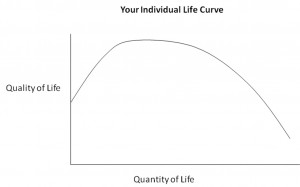As individuals who make a habit of eating healthfully and exercising regularly, from time to time we find ourselves defending our healthful lifestyle choices. Many of you who are reading this have likely experienced this as well. People are often interested, and sometimes appalled, to hear that we would rather spend a Friday night in the gym than at happy hour, or that we would gladly choose some dark green leafy vegetables over a side of bacon. In effort to explain (and perhaps justify, depending on the audience) these healthful lifestyle choices, we have tried out many different lines of reasoning.
Generally it seems we think of our lives as a string with a definite beginning and an end. Your life begins when you are born, and it ends when you die. When we think about our lives this way, it leads us to consider health in a one-dimensional fashion. Most health-related matters eventually boil down to whether or not they will immediately sever your lifeline. I am sure you have heard someone lament that a particular activity or food “is not going to kill you” implying that if death is not a likely outcome, then it is without consequence. This sort of thinking also makes healthful eating and regular exercise somewhat easy to dismiss because, let’s face it, our life could end abruptly at any moment. And it seems reasonable to conclude that since “life is short” we may as well have a good time while we can and not worry all the time about extending our lifeline, right? That all can seem logical given a limited amount of information, but perhaps there is more to the story.
The concept of a life curve expands on the idea of the lifeline by adding a second dimension, and it looks something like this:
In the above illustration, the x-axis represents how long we will live, just as it does in the one-dimensional representation of your life. The y-axis represents our quality of life. The higher up the life curve is on the y-axis, the better the quality of life. Here ‘quality of life’ is representative of many things. For example, immune system strength, bone density, body composition, energy level, the ability to concentrate, and how far you can run are all examples of quality of life. The list is seemingly endless, and can best be prioritized by you.
‘Quality of life’ is a relatively abstract term, but this concept can significantly change our thinking. Length of life is no longer paramount, but secondary to how we will feel each and every day while we are alive. And all of our actions matter. Everything that we eat, all of the exercise that we do, how much sleep we get each night, and our overall level of stress, among many other things, all impact quality of life. Our behavior has real and tangible consequences that will be felt not only in the short-term, but in the long-term as well. Decisions that we make each and every day have the potential to impact the rest of our lives.
The next time that someone is giving you a hard time for choosing water instead of wine, spending an extra fifteen minutes on the treadmill, or forgoing the cheese on your sandwich, encourage them to add a second dimension to the way they consider their lifeline. You may just have an easier time justifying your position.

